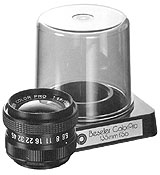|
Beseler
is pleased to offer a series of enlarging lenses designed to
comp- lement the finest camera optics. They are not simply very
good lenses - they represent the absolute state of the art in
premium quality enlarging optics.
THE
REQUIREMENTS
The first quality most photographers look for in an
enlarging lens is sharpness. To an optical designer, sharpness
is actually the sum of two equally important factors: resolution
and contrast.
An enlarging lens should also have two qualities
very different from what you'd look for in a camera lens. It
should be optimized for use at relatively close working
distances, and have a flat field to insure edge to edge
sharpness of the projected image.
Naturally, a fast lens is also desirable to make
focusing easier and to keep exposures short. Color correction is
another must. All colors must be focused in the same plane or
color fringing and loss of sharpness can result.
|

|
|
In short, an enlarging lens should have superb resolution and
contrast, a magnification range which matches the film format for
which it's intended, a flat field and critical correction of
chromatic aberrations. And, of course, these qualities should be
as even as possible, corner-to-corner.
Based on years of experience, and using the very
latest optical glass formulations, coating techniques and computer
design programs, Beseler ColorPro lenses match or exceed any other
enlarging lens anywhere, in every department.
QUALITY
ENGINEERING
ColorPro lenses are of a very special
quality, in both optical and mechanical terms, human engineered
for ease of use. For example, ColorPro lenses use eight diaphragm blades, so the aperture is more nearly
circular compared to lenses that use only three or six blades.

The aperture ring is rubberized for a sure grip (but it's metal
underneath), and Beseler maintains strict control of the
rotational force required to adjust the aperture, so the lens
operates smoothly throughout the entire range.
|
Aperture
numbers are exceptionally large and easy to read. Every part is
sturdy, well made, precisely ma- chined for a lifetime of service.
Optically the lenses are hand as- sembled, each element
individually
centered and checked for a precisely aligned optical axis.
For the greatest convenience, all Beseler ColorPro
lenses have stan- dard 39mm Leica mounting threads, and 40.5mm
front accessory threads.
OPTIMUM
MAGNIFICATIONS
Any lens is designed with an
"optimum conjugate"... a magnification factor at which
the lens performs at it's very best. That factor is somewhere in
the middle of a range in which the lens produces excellent
results. ColorPro lenses are designed to work best at the
magnifications you're most likely to use. - and that varies with
each lens. For example, the 50mm f/2.8 ColorPro, which is
ideal for 35mm negatives, has an optimum conjugate of 8X, which
would produce a slightly cropped 8x10 print. The magnification
range of this lens is from 2X to 20X. The other lenses, which are
for larger negatives and transparencies, have 5X optimums,
with 2X to 10X ranges.
|
WHICH
LENS?
The focal length of the
lens that's best for any given negative or transparency format is
generally similar to what would be the "normal" camera
lens for that format. For example, 50mm lenses for the 35mm
format, 75mm lenses for 2¼ square. These are the focal lengths
which deliver the greatest possible degree of magnification.
Beseler ColorPro lenses are made in a wide variety of
focal lengths so you can always have exactly the right lens for
any film format.
|
Beseler
ColorPro Lenses |
Film
Format |
|
50mm f2.8 |
35mm |
| 75mm f4.5 |
6 x 6cm |
| 90mm f5.6 |
6 x 7cm |
| 105mm f5.6 |
6 x 9cm |
| 135mm f5.6 |
4 x 5 |

©
1979 BPM
|